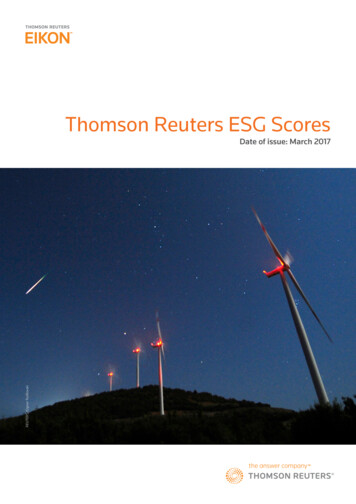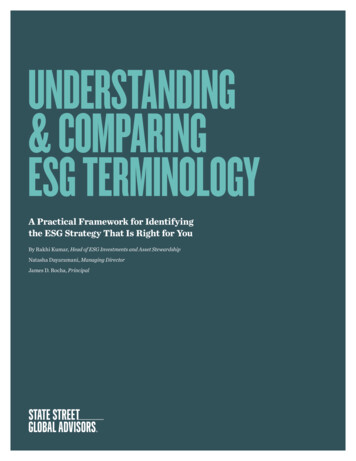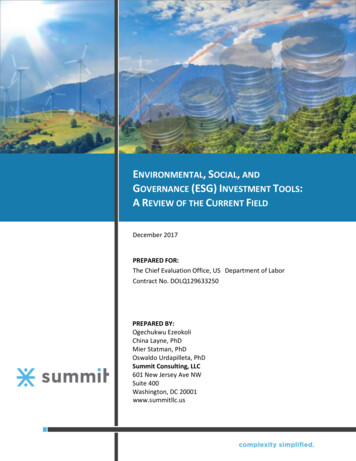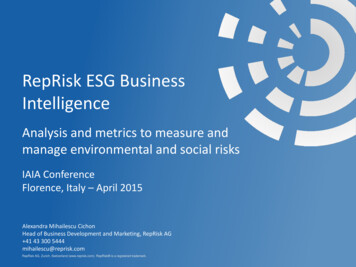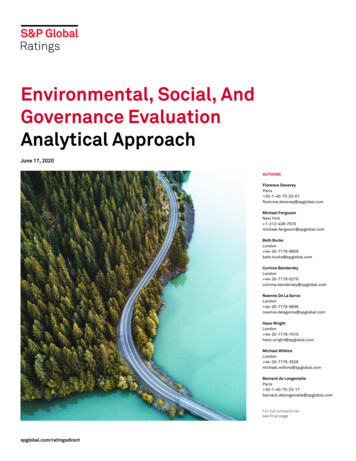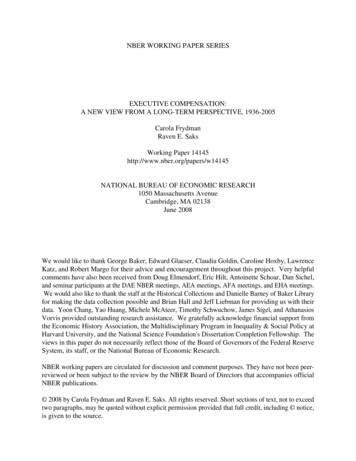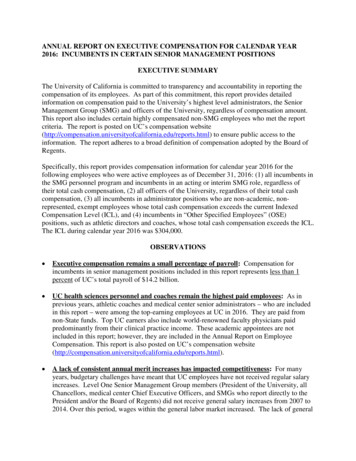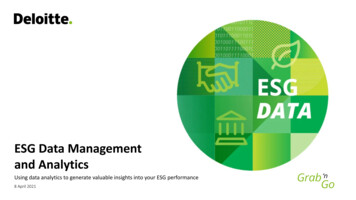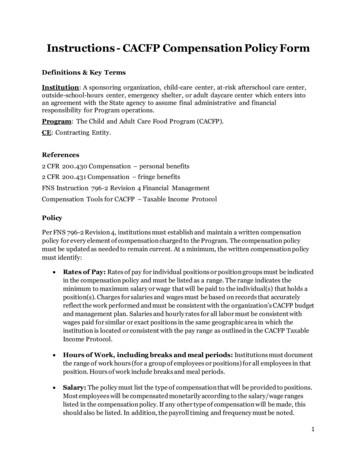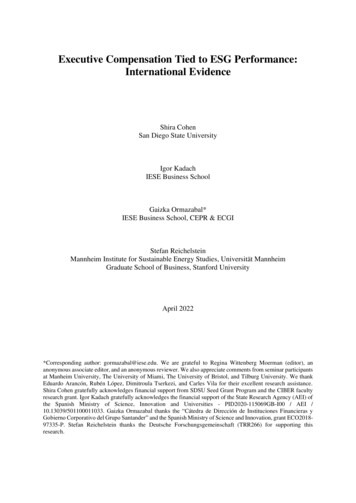
Transcription
Executive Compensation Tied to ESG Performance:International EvidenceShira CohenSan Diego State UniversityIgor KadachIESE Business SchoolGaizka Ormazabal*IESE Business School, CEPR & ECGIStefan ReichelsteinMannheim Institute for Sustainable Energy Studies, Universität MannheimGraduate School of Business, Stanford UniversityApril 2022*Corresponding author: gormazabal@iese.edu. We are grateful to Regina Wittenberg Moerman (editor), ananonymous associate editor, and an anonymous reviewer. We also appreciate comments from seminar participantsat Manheim University, The University of Miami, The University of Bristol, and Tilburg University. We thankEduardo Arancón, Rubén López, Dimitroula Tserkezi, and Carles Vila for their excellent research assistance.Shira Cohen gratefully acknowledges financial support from SDSU Seed Grant Program and the CIBER facultyresearch grant. Igor Kadach gratefully acknowledges the financial support of the State Research Agency (AEI) ofthe Spanish Ministry of Science, Innovation and Universities - PID2020-115069GB-I00 / AEI /10.13039/501100011033. Gaizka Ormazabal thanks the “Cátedra de Dirección de Instituciones Financieras yGobierno Corporativo del Grupo Santander” and the Spanish Ministry of Science and Innovation, grant ECO201897335-P. Stefan Reichelstein thanks the Deutsche Forschungsgemeinschaft (TRR266) for supporting thisresearch.
Executive Compensation Tied to ESG Performance:International EvidenceABSTRACTThis paper examines the use of ESG performance metrics in executive compensation contracts.We first document that a growing fraction of publicly traded companies around the world nowincorporate ESG metrics in the compensation schemes of their top executives. Our analysis linksthe reliance on these metrics to firm fundamentals, the geographic location of firms as well as theinfluence of institutional shareholders. Our findings also suggest that the adoption of ESGvariables in managerial performance measures is accompanied by improvements in ESGperformance and meaningful changes in the compensation of executives.Keywords: ESG metrics, Executive compensation, Institutional ownership.JEL Classifications: M12, M41, Q54.
1. IntroductionWith the rising interest in Corporate Social Responsibility (CSR) principles a broad set ofEnvironmental, Social and Governance (ESG) variables have been proposed as metrics for gaugingcorporate CSR efforts. As might be expected, the proportion of global firms indicating that theirexecutive compensation schemes are tied to ESG metrics has also grown. According to the globalISS Executive Compensation Analytics database, the share of firms indicating that some ESGmetrics are Key Performance Indicators (KPI) for their executives has grown from 3% in 2010 toover 30% in 2021.1The practice of including ESG metrics in executive compensation schemes (henceforthreferred to simply as “ESG pay”) raises two broad sets of questions: who are the adopters of ESGpay and what economic outcomes are associated with the inclusion of ESG metrics in executivecompensation schemes? More specifically, what characteristics, such as geographic location, size,industry and ownership structure, tend to make firms more prone to adopt the practice of ESGPay? Furthermore, what economic outcomes, such as ESG performance and financial returns dowe observe for the adopters of ESG pay? This paper examines whether the factors predicting ESGadoption and the subsequent economic outcomes result in a pattern that is consistent with thenotion of ESG metrics playing a meaningful role in executive compensation arrangements.From an agency and stewardship perspective, one would expect reliance on ESG metricsin executive compensation packages, provided a firm’s owners and the Board of Directors actingon their behalf intrinsically care about ESG outcomes (Bonham and Criggs-Cragun, 2022).2 Someinstitutional equity investors, e.g., BlackRock, have urged firms to articulate their sustainability1See Figure1 for the actual growth rates between 2010 and 2020. The available data for 2021 indicates that thepercentage of firms basing executive pay on some ESG metric has most recently grown to 38%.2Recent studies in finance have suggested that some investor groups are willing to compromise financial results forimprovements in certain ESG scores (Pastor et al., 2020; Riedl and Smeet, 2017; Barber et al., 2021).1
agenda because of impending financial risks resulting from climate change. Accordingly,environmental metrics, such as carbon emissions, are viewed as indicators of future financial risk.The justification for ESG pay would then be in line with earlier agency-theoretic findingsdemonstrating that reliance on operational metrics, such as product quality or customersatisfaction, can make managerial incentive contracts more efficient. 3 This prediction emergeseven if the firm’s share price, a key indicator of future performance, is available for contractingpurposes.4A distinctive characteristic of many ESG metrics, in particular those in the “E” and “S”categories, is that some of the firm’s stakeholder groups intrinsically care about these metrics. Thisreflects that some of the firm’s activities entail external effects, the costs of which are not fullyinternalized by the firm. A firm’s greenhouse gas emissions or other environmental pollution areprime examples in this context. By including ESG metrics for activities subject to external costsin executive compensation schemes, owners can credibly convey to the firm’s stakeholders thatmanagement’s attention will be drawn to these external effects. In addition to improving thegeneral corporate image, a firm commitment to be “ESG conscious” may strengthen customerloyalty and make the firm’s equity shares more attractive for certain investor groups.The literature on CSR has long been concerned about the possibility of “window-dressing”or “green-washing” (Delmas and Burbano, 2011; Marquis et al. 2016; Grewal and Serafeim, 2021).In the context of ESG pay, window-dressing may be tempting for firms whose owners are skepticalregarding the financial benefits emerging from higher ESG scores, except for the general benefitthat results from improving the firm’s corporate image and its standing with certain stakeholder3See, for instance, Ittner, Larcker, and Rajan (1997), Dikolli (2001), Sliwka (2002), and Dutta and Reichelstein (2003).Conversely, the need for accounting variables in addition to stock price has been demonstrated, among others, byBushman and Indjejikian (1993); Kim and Suh (1993), Paul (1992) and Dutta and Reichelstein (2005).42
groups. Ideally, those firms would like to be perceived as being “ESG responsible” without havingto “walk the talk”. Window-dressing is arguably difficult to detect in the context of ESG paybecause the measurement of these variables is frequently subjective at the firm level. Furthermore,outside observers generally do not have access to the relative weights given to differentperformance indicators, the use of targets and thresholds, as well as the exact form of the payoutfunction.Our empirical tests are based on the ISS Executive Compensation Analytics database,covering a sample of 4,395 public firms from 21 countries between 2011 and 2020. We count afirm as practicing ESG pay if at least one ESG criterion was considered a key performanceindicator in the firm’s executive compensation scheme. The criteria span a wide range of “E”, “S”and “G” variables.Our analysis shows that several external factors appear to make firms more prone to adoptESG pay. At a macro level, the inclusion of ESG metrics in compensation contracts is morecommon in countries that are generally perceived to be ESG sensitive, including the possibilitythat some form of ESG reporting is already mandatory in these countries. As one might expect,firms operating in environmentally burdensome industries also have a higher proclivity to adoptESG pay. At the firm level, we find that, aside from size and volatility, the practice of ESG pay isassociated with firms that have publicly issued environmental commitments.We take a detailed look at the impact that institutional investors have on the practice ofESG pay. Institutional investors are often seen as leaders in the current effort to transition towardsmore sustainable business practices, yet there is also an ongoing debate on the growing influenceof large asset management companies. Our analysis of the determinants of ESG pay breaks downinstitutional ownership in several ways. We use an instrumental variables approach to isolate3
exogenous variation in institutional ownership. In addition, we collect data on engagements by thethree largest institutional investors (i.e., Blackrock, State Street, and Vanguard) and find that theirengagements tend to increase the likelihood of a particular firm implementing ESG pay. Finally,when analyzing investors’ reaction to ESG pay, we find that funds tend to tilt their portfoliostowards firms that do rely on ESG pay.In terms of subsequent outcomes observed for ESG adopters, we find that these firmsreceive on average more favorable ESG scores from outside rating agencies. ESG pay adoptersalso tend to experience improvements for one key environmental ESG metric: the firm’s carbondioxide emissions. These patterns are more pronounced among ESG sensitive countries,specifically countries within the European Union. In terms of executive compensationconsequences, our results indicate that after controlling for accounting and stock priceperformance, executives of firms exhibiting higher ESG ratings and lower CO2 emissions receivehigher variable compensation. This finding does not apply to firms that do not condition theircompensation arrangements on ESG variables.The effect of ESG pay on shareholder wealth is less clear-cut. We find no positiveassociation with financial outcomes, such as return on assets, and even find a decrease in stockreturns after the adoption of ESG pay. These findings are consistent with the notion that someinvestment groups are insistent on attention to ESG criteria and are willing to trade improvementsin those dimensions for lower returns. Taken together, our findings on the determinants of andoutcomes associated with ESG pay are consistent with the hypothesis that ESG pay provisionsplay a substantive role in executive compensation packages by supplementing traditional financialmetrics.4
To date, there appear to be relatively few studies examining the link between executivecompensation and CSR activities. Somewhat complementary to our approach, some studies haveasked whether basing compensation on CSR-contingent variables results in increased agencycosts, possibly without increasing shareholder value. Higher agency costs may be the consequenceof top-level managers having intrinsic CSR preferences and their power to lobby boards ofdirectors to include CSR variables in executive compensation contracts. Some of these studies findthat contracting based on CSR criteria is more common among firms with relatively less powerfulCEOs (Hong et. al, 2016; Ikram et al. 2019).5 In contrast, Bebchuk and Tallarita (2022) concludethat a broader set of KPIs allow executives to extract larger rents at the expense of shareholders. 6Our result that institutional investors have a significant role in firms’ decision to adopt ESGpay adds to the burgeoning literature on the effects of environmental activism on corporations(Dimson et al. 2015; Azar et al. 2021). Closely related to our study is Dimson et al. (2015), whostudy the activism of one large institutional investor with a major commitment to responsibleinvestment. Consistent with our findings, Azar et al. (2021) demonstrate that the Big Three appearto push firms towards incremental reductions in carbon emissions.The remainder of the paper is organized as follows. Section 2 develops our hypotheses onthe determinants of and outcomes associated with ESG pay, while Section 3 describes our dataand sample. Section 4 reports the empirical findings on the determinants of ESG pay. Section 5extends the analysis on the influence of institutional investors. Section 6 focuses on the observed5Relatedly, Flammer et al. (2019) conclude that integrating CSR variables into executive compensation tends toimprove firms’ financial performance. Maas (2018) finds that quantitative, hard corporate social performance targetsis an effective way to improve CSR results.6These previous studies are restricted to the U.S. where we observe less frequent use of ESG pay. Moreover, theiranalyses are based on a relatively small cross-section of firms (S&P100 or S&P500) and data from years prior to 2014,a period in which ESG pay was relatively uncommon. (see Figure 1).5
outcomes associated with the inclusion of ESG metrics in compensation contracts. We concludein Section 7.2. Conceptual framework and empirical predictionsOur analysis is grounded in a conceptual framework that presumes heterogeneity in thepreferences of shareholders across the firms represented in our sample. Specifically, we envisionthat there are (at least) three types of firms differing in their owners’ preferences regarding thefirm’s ESG performance. We refer to Type I firms as those where the majority of shareholderssubscribe to Friedman’s postulate that the objective of businesses should be to maximize economicprofits (Friedman, 1970). Furthermore, the owners of these firms believe that the ESG metricspopularized in recent years either have no first-order effect on the firm’s financial performance, orthat the signal-to-noise ratio of these metrics is sufficiently low to render them effectively uselessfor incentive contracting purposes. We expect these firms in our sample not to base executivecompensation on ESG variables.At the other end of the spectrum, Type III firms will engage in ESG pay for their executiveseither because the owners intrinsically care about ESG outcomes, or because they view ESGvariables as leading indicators of future financial performance.7 These leading indicators maycapture risk exposures, such as the risk of stranded assets due to accelerating climate change.Agency models suggest that both are rational arguments for basing executive pay on ESG metrics(Sliwka, 2002; Dutta and Reichelstein, 2003; Bonham and Criggs-Cragun, 2022). When ESGvariables are viewed as mere leading indicators of future financial performance, the case for ESG7Some studies on the use of ESG in compensation schemes have conjectured that ESG variables may present yetanother convenient instrument for powerful executives to camouflage and justify excessive compensation in theguise of “pay-for-performance” (Bebchuk and Tallarita, 2022).6
pay is similar to that for the inclusion of non-financial variables, e.g., customer satisfaction orproduct quality, in managerial incentive contracts (Ittner, Larcker and Rajan, 1997; Dikolli, 2001).In the middle of our taxonomy, we envision Type II firms. Like Type I, the owners of TypeII firms are “ESG skeptics”, except that they anticipate financial benefits if the firm is beingperceived as “ESG active” by various stakeholder groups, including customers, employees, andcertain investor groups. These stakeholders intrinsically care about the firm’s ESG outcomesbecause many of the “E” and “S” variables in ESG pertain to activities that entail external costswhich are not fully reflected in the prices of goods and services transacted by the firm. Greenhousegas emissions or labor practices in foreign countries are cases in point. Firms that are viewed asbeing concerned about these variables may therefore improve their standing with thecorresponding stakeholder groups, resulting in, for instance, increased customer loyalty, strongerbrand value, better labor relations, and a broader set of investment clients.Owners of Type II firms will therefore seek to convince the concerned stakeholders thatthey indeed incentivize their management to pay attention to ESG. Given their intrinsic ESGskepticism however, these owners and their appointed boards of directors may want to implementESG pay in only a nominal fashion, that is they engage in “window-dressing”. The concern thatfirms could use ESG pay opportunistically stems from the substantial degree of discretion thatcompanies have when it comes to implementing ESG pay.8 In particular, they can choose thecompensation vehicle, the relative weights attached to different metrics, performance targets, andthe specific ESG metric(s). These concerns are exacerbated by the difficulty in measuring manydimensions of ESG.8Based on a sample of S&P100 firms, Bebchuk and Tallarita (2022) note that among those firms that disclosed therelative weights given to ESG variables in executive compensation schemes, the reported weights were rather smallon average, i.e., in the range of 1-3%.7
While these firm types are not directly observable, we can gain some understanding of theirrelative proportion in our sample by exploring which firms adopt ESG pay and whether theadoption of ESG pay is associated with improvements in ESG performance.2.1. Determinants of ESG payIndustry- and Country Level Determinants. The tendency to base executive compensationon ESG metrics is plausibly higher for firms operating in environmentally burdensome segments,specifically in heavy manufacturing industries. Similarly, we expect a higher proclivity to adoptESG pay for firms located in countries that are either considered to be sensitive to environmentalprotection and/or have regulations in place that mandate corporate ESG disclosures.Firm Fundamentals. ESG pay could be associated with firm fundamentals in several ways.We expect firms exhibiting greater volatility to be more likely to implement ESG pay, since forthese firms ESG metrics could be informative about future performance, i.e., ESG variables areleading indicators of future financial performance. We also expect larger firms to be more likelyto implement ESG pay since the environmental and social management practices of larger firmsare more visible to the public.ESG Pledges. We predict that firms with pledges to improve ESG scores will seek to lendfurther credibility to these commitments by tying executive compensation to ESG metrics. Aprominent example are carbon reduction pledges. Carbon dioxide (CO2) emissions is the metricmentioned most prominently in connection with environmental ESG variables. As part of theirsustainability efforts, a sizable number of global firms have recently articulated net zero pledges.Accordingly, these firms have stated the goal to reduce their emissions (gross emissions less socalled offsets) to zero by 20xx, where frequently xx 50. Yet, critics have argued that these selfimposed targets often lack credibility, as the firms do not specify how they are to achieve these8
ambitious targets 30 years into the future (Comello et al. 2022). To strengthen the credibility oftheir net zero pledges, a substantial number of firms have partnered with NGOs such as theScience-Based Target initiative (SBTi).9 We therefore examine the association between firmssigning up with the SBTi and adopting ESG pay.Shareholder pressure. Survey evidence suggests that a nontrivial number of institutionalinvestors believe that climate risks have financial implications for their portfolio firms (Kruegeret al. 2020). That said, it is plausible that a substantial number of investment fund managers maythemselves be agnostic in their beliefs regarding the relationship between ESG criteria andfinancial performance. Yet, they may push for the adoption of ESG metrics in the executivecompensation schemes of the portfolio companies for fear of losing their investment clients withan intrinsic ESG preference.10 Indeed, recent research in finance has argued that some investmentgroups are willing to trade financial returns for improvements in ESG performance (Pastor et al.,2020; Riedl and Smeet, 2017; Barber et al., 2021; Kruger et al., 2020).11 Because these investmentclients are frequently represented by institutional equity investors, it is plausible that, even if themanagers of these institutions are skeptical about ESG, a larger share of institutional ownership isassociated with a higher proclivity to adopt ESG metrics in executive compensation schemes.In his annual letters to CEOs, BlackRock’s CEO Larry Fink has been explicit that, in orderfor firms to be eligible portfolio companies for BlackRock, they need to be transparent about their9Launched in 2014, the Science-Based Targets Initiative (SBTi) seeks to define and promote net-zero carbon emissiontargets in line with climate science. The list of companies that have set emissions reduction targets through the SBTIis available on the Emission Pledge’s web-site: ction#anchor-linktest.10For example, the equilibria emerging in the model of Friedman and Heinle (2016) has the feature that investorseffectively exert pressure on management to improve the firms’ sustainability practices.11For further evidence on investors’ preferences towards ESG see also Hartzmark and Sussman (2019) and Ceccarelli,Ramelli, and Wagner (2021).9
sustainability practices.12 Mr. Fink has also been explicit that this insistence does not reflectBlackRock being a climate activist. Instead, BlackRock’s position supposedly reflects the beliefthat climate change poses a long-term financial risk to many corporations, in part due to impendingregulatory risk, and yet these risks may not be properly reflected in current share prices.13Directors’ preferences. The push/resistance to adopt ESG pay could also relate to directors’preferences. For example, it is plausible that independent directors are in favor of ESG pay becausereputational concerns make these directors sensitive to external pressure to implement ESGstrategies. Moreover, based on prior literature showing that female directors are more sensitive toESG issues (Atif et al., 2021; Ginglinger and Raskopf, 2021; Liu, 2018), it is possible that ESGpay is more prevalent among firms with more female directors.14In sum, the above determinants should lead firms in the Type II and III categories to includeESG variables among their KPIs. We therefore expect to see a positive association. In contrast,such an association should not emerge for the non-adopters of ESG pay (Type I firms).2.2. ESG performance associated with ESG payPay for ESG performance. If firms merely seek to claim the “green mantle” by nominallyincluding ESG metrics in executive compensation schemes (type II firms), there should be noassociation between ESG performance and the cash bonuses received by the firm’s executives. Incontrast, we would expect to see a positive association for type III firms.The annual letter to CEOs in 2020 stated: “we will be increasingly disposed to vote against management and boardof directors when companies are not making sufficient progress on sustainability-related disclosures and the businesspractices and plans underlying them” (Sprouse, 2020).13Generation Investment Capital is another example of an equity fund emphasizing that long-term value maximizationrequires management practices that are environmentally and socially sustainable (Bebb and Reichelstein, 2016).14See also Adams and Ferreira, 2009; Cronqvist and Yu (2017) for other research with consistent conclusions on theeffect of women on corporate decision-making and, specifically, on CSR.1210
Changes in ESG performance. If ESG pay provisions are substantive (Type III firms), weexpect that those firms that adopt ESG pay will improve their ESG performance.i)Carbon Emissions. Since corporate CO2 emissions are frequently a primary ESGmetric, we expect that, in comparison to non-adopters of ESG pay, the adopters willachieve significant reductions in their levels of CO2 emissions. We expect this relationto be particularly strong for firms that single-out carbon based metrics among their KPIs.ii) ESG Ratings. The reasoning provided for carbon emissions as an outcome variableapplies equally to ESG ratings that the firm in question receives from external ratingagencies, such as Sustainalytics or Refinitiv.In sum, if the adoption of ESG pay is associated with the determinants hypothesized aboveas well as with improvements in ESG performance, the findings would suggest that Type II firmsare relatively rare in our sample.3. Data, Sample, and Descriptive Statistics3.1. Data and SampleOur initial sample includes international public firms covered by ISS ExecutiveCompensation Analytics (ECA) from 2011 to 2020. ECA provides detailed, comparable data onincentive awards, including performance metrics, performance goals and payout structures on allincentive awards for over 9,000 companies across the U.S., Canada, U.K., Europe, Australia, NewZealand, and South Africa. Although the ECA database starts in 2008, comprehensive coverage ofperformance metrics used in compensation contracts is only available from 2011.15 Our analysisends in 2020, the last year with complete available data at the time of our study.15Unfortunately, the data on performance goals and payout structures is not available for many firms covered by thedatabase.11
Aside from the ECA data on compensation contracts, our analysis incorporates separatedata sources on greenhouse gas emissions, ESG ratings and institutional ownership on individualfirms. Trucost, a commercial provider of corporate carbon emission data, is a widely used sourceof firm carbon emissions data for the corporate sector (for example, MSCI and S&P use Trucostdata in their indexes) and for international organizations such as UNEP FI (i.e., the United NationsEnvironment Program Finance Initiative). Trucost collects carbon emissions data from publiclyavailable sources, including the Carbon Disclosure Project.16 When a covered firm does notpublicly disclose its carbon emissions, Trucost estimates a firm’s annual carbon emissions basedon an environmental profiling model.We obtain data on institutional ownership from the FactSet/LionShares database.FactSet/LionShares gathers institutional ownership for U.S. equities from mandatory filings withthe SEC. For stocks traded outside the U. S., FactSet/LionShares gathers institutional ownershipdata from national regulatory agencies and stock exchange announcements, as well as directdisclosures of mutual funds, mutual fund industry directories, and company proxies and annualreports. We obtain accounting and market data from Datastream/WorldScope. This data setprovides stock price, balance sheet, and income statement information for a large number ofinternational firms. We collect data on commercial ESG Ratings sources from Refinitiv,Sustainalytics, and MSCI (ESG KLD Stats).Table 1, Panel A, outlines the sample selection procedure. We start with 53,565 firm-yearobservations in the ECA dataset. To be included in our sample, we require that the firm is publiclytraded and is covered by Datastream and FactSet/LionShares. The resulting sample consists of35,076 firm-year observations corresponding to 6,262 firms. Some of the tests require non-missingOther sources of carbon emissions data include companies’ websites, annual reports (10-K), CSR reports, and directcommunications with companies.1612
Trucost data, which further restricts the sample size to 22,603 observations corresponding to 4,395firms from 21 countries.Table 1, Panel B, presents the sample composition by year. The table shows a remarkableincrease in the number of firms adopting ESG pay over the sample period, with the increase beingmost pronounced in the latter part of the sample. This is consistent with a substantial body ofevidence of a significant increase in the social sensitivity towards ESG in these recent years (e.g.,Azar et al., 2021). As shown in the table, a non-trivial number of firms have implemented ESGpay by the end of our sample period (1,198 firms, corresponding to 31% of our sample firms in2020).Table 1, Panel C, presents the sample composition by country. We observe that the use ofESG pay is more common among European countries, Australia, and Canada. The table also showsthat the frequency of ESG pay in the US is significantly lower than that in these countries. This isconsistent with evidence suggesting that societies within the EU being more sensitive to ESGissues (Gibson et al., 2020).Table 1, Panel D, presents the sample composition by industry. ESG metrics are mostcommonly used in the compensation contracts of producers of oil and petroleum products, utilities,and automakers. That is, ESG pay appears to be more prevalent in industries that areenvironmentally controversial.3.2 Firm, industry, and country characteristicsTable 2 presents descriptive statistics of the variables used in our tests.17 Panel A presentsthe summary data for the pooled sample and Panel B distinguishes between observations with and17Continuous variables are winsorized at the top and bottom 1%.13
without ESG pay. Table 2, Panel B, shows that firms with ESG pay are larger, exhibit higher CO2emissions, higher ESG ratings, and are more likely to make environmental pledges.3.3 Contract characteristicsTable 3 presents summary data on the characteristics of compensation contracts containingESG metrics. Panel A presents a taxonomy of the ESG metrics we observe (see Table 3 for thenumber of sample firms using each type of metric and Appendix B for examples of each type). Asshown in Panel A, most of our sample firms use metrics related to environmental dimensions.Indicators related to carbon emissions are popular but, as shown in the table, firms also use a widerange of other environmental metrics. On the social dimension, Table 3 also reveals that firmsoften use indicators related to safety and security, diversity and inclusion, and employeesatisfaction/development. We also observe metrics related to governance, mos
IESE Business School Gaizka Ormazabal* IESE Business School, CEPR & ECGI Stefan Reichelstein Mannheim Institute for Sustainable Energy Studies, Universität Mannheim Graduate School of Business, Stanford University April 2022 *Corresponding author: gormazabal@iese.edu. We are grateful to Regina Wittenberg Moerman (editor), an anonymous .
